Ruchira tells us about the many rituals of Bengali wedding, in the weekly column, exclusively for Different Truths.
Twenty-six years ago I got hitched. However, I had neither the time nor energy to undergo a traditional ritualistic Bengali wedding. It was a simple court affair. Nevertheless, I love to attend Bengali wedding ceremonies which I find rather fun-filled and interesting. So here goes:
Bengali Biye (wedding) commences with Pakaa Dekha (literally: finalising the wedding). This is some sort of an engagement where generally the closest members of the two families are present. It is a low-key affair. The elders of both parties bless (aashirbaad) the bride and groom-to-be and gift them mainly light jewellery items e.g., rings, chains, etc. A feast is organised to mark the occasion.
Between the Paaka Dekha and the main wedding, there is a popular custom known as Aaibudo Bhaat. This is equivalent to stag parties in Western cultures. The girl and the boy are invited by their respective relatives and dear ones and treated to sumptuous meals.
Moving on, another set of rituals begin on the wedding day itself. In their respective homes, the bride and groom are woken up before dawn for Dadhimangal. They are fed on a hi-calory diet of curd, Chira (rice flakes) and sweets (notably the perennial favorite Sandesh), served in a mishmash form, the ingredients are meant to sustain the duo till the dead of night when the wedding is over. This used to be the traditional practice though now there are growing instances of friends of the couple smuggling in eatables for the fasting pair when nobody is watching.
 A few hours later it is time for Vriddhi (a.k.a Nanimukh). The bride ’s father along with his daughter pay homage to their ancestors and dear departed ones, in the process they als0 seek blessings for her blissful conjugal life. As a part of this ritual, the bride dons the ceremonial pairs of Shankha Pawla (bangles made of conch shells & coral). A similar ritual is conducted at the groom’s home
A few hours later it is time for Vriddhi (a.k.a Nanimukh). The bride ’s father along with his daughter pay homage to their ancestors and dear departed ones, in the process they als0 seek blessings for her blissful conjugal life. As a part of this ritual, the bride dons the ceremonial pairs of Shankha Pawla (bangles made of conch shells & coral). A similar ritual is conducted at the groom’s home
Next, comes the Gaaye Holud (equivalent to Haldi ceremony in other states). At the groom’s house, a bunch of five elderly married women pound raw turmeric into a paste and then apply it on his hands and face. Thereafter, he is given a ceremonial bath with water from a nearby pond, lake, or river which is brought home in a vessel earlier in the day by the same set of women.
Afterward, a bowl of the turmeric paste is dispatched to the bride’s home along with what is termed Gaaye Holuder Tatva (sacred gifts for the bride). This array comprises a fresh, huge, uncut fish, and sweets among other things. After the turmeric paste, along with the other goodies arrives at the bride’s place, she too is given a ceremonial bath following turmeric application. Gaaye Holud is greatly significant because everyone fervently hopes that the couple would remain inseparable from one another lifelong.
Bengali weddings never take place during the daylight hours. The earliest auspicious moment or Lagna (muhurat) is twilight (godhuli lagna). It is considered highly auspicious and romantic as well. In case of later lagnas, nuptials continue till wee hours of the night.
Prior to the wedding, the bridal makeup and grooming usually take place in the afternoon; the bride wears gold jewellery interspersed with floral garlands of diverse sizes. Nowadays, the brides rush to the numerous beauty parlours that have mushroomed everywhere.
It is mandatory for the bride’s family to send a few male members to escort the groom to the wedding venue (read bride’s home). The groom wears a resplendent silk Punjabi (kurta) teamed off with an impressive dhoti. He also dons an impeccably white garland woven with fresh aromatic flowers. Before leaving the house, the grooms seeks his mother’s permission to fetch a daasi (housemaid /his bride) for her. In modern times feminists are virtually up in arms against the obnoxious word; hence it has been replaced by bou or daughter-in-law or Laxmi, the mistress of the home.
A Bengali wedding process is devoid of Baand Baja and other elements of pomp and show. Nor does the groom ride a mare. On the contrary, he quietly travels in a car/cab decorated with flowers and colourful ribbons. The Baraati or Bor Jatri are sober, not inclined to dancing and drunken revelry unlike the popular practice in other states. When the Bor Jatri reaches the bride’s place, women folk including the bride’s mother, aunts, grannies welcome the groom by doing Arati with an earthen lamp, and other sacred objects placed on a bamboo winnowing basket (Kulow). As part of the Baran ritual, the groom is served sweets and soft drinks. He is then led to the sanctum sanctorum where he is offered a set of new clothes by an elderly male of the family who later performs the Sampradan (kanyadaan).
Importantly throughout the ceremonies, the groom must wear a conical headgear (Topor) made of shola pith. The bride wears an ornate crown (Mukut) made of the same substance.
The bride is ushered into the wedding site (chhandantola) – seated on a low wooden stool (pidi) her face covered with paan (betel) leaves – by her male siblings, cousins and is taken around the groom in seven complete circles. This ritual symbolizes the couple is inextricably linked to one another. For general awareness: instead of sitting on a pidi the bride also has the option of circumambulating her spouse by walking. After saat paak (7 circumambulations around the holy fire) the bride and the groom face each other and look deeply into each other’s eyes. This is termed as Shubho Drishti.
Thereafter, the couple exchanges garlands (Maalabodol) thrice each, symbolising their mutual acceptance.
The bride and groom are then seated across each other, at the altar; an elderly member of the bride’s family symbolically hands her over to the groom. Amidst recital of Vedic hymns, the couple’s hands are bound by sacred threads and are placed on the Mangal Ghot – a brass pitcher filled with water that is covered with mango leaves attached to one twig and a green coconut placed on it. The bride and groom sit in front of the sacred fire and chant mantras after the priest. At this juncture Agni, the fire god is invoked to witness the marriage. Now it is time for Saptapadi wherein the couple walks around the fire seven times, uttering solemn vows.
Homa /Anjali: The couple makes offering to the fire deity. The bride’s brother puts puffed paddy (Khoi) in her hands, while the groom standing close behind her, clasps her hands, then stretching their arms forward they pour the libation into the blazing fire.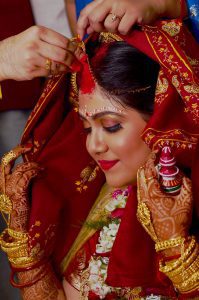
Once again the duo sits beside each other and the groom applies sindoor (vermilion) in the parting of her hair. Her head is then covered with a new sari – known as Lajja Vastra – offered by the groom.
After the wedding is over the couple is served a lavish dinner. Thereafter, they are led to the Bashar Ghar. The bride’s siblings, relatives, aunts and many a female guest flock the duo to indulge in light banter, leg pulling, mock quarrels and so forth. The entire night is spent in this way.
The following morning, when it is time for the newly-weds to depart, the atmosphere gets heavily charged with emotions. In a tearful frame of mind, the bride throws handfuls of rice into the anchal of her mother’s sari, three times in a row – thereby symbolically repaying all her debts towards her parents. This is known as Kanakanajli. Again this is not a major ritual and is overlooked in some families.
When the bride arrives at her new home she is subjected to a similar Baran ritual which was extended earlier to the groom. In some families, a huge urn containing milk tinged with Aalta (lac dye) is placed before the bride. She dips her feet into the fluid and then steps onto a spotless red-bordered sari. This is Dudhe Aaalta.
On the first night in her new home, the bride stays away from her spouse and sleeps in a different chamber. This is known as Kaalratri.
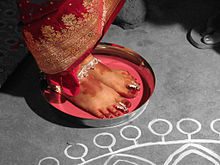 In yet another step to accept the bride within the family the ritual of Boubhat is organised. The bride cooks and serves spinach, ghee with rice, to all the elderly members of her husband’s family. In the process, she seeks their good wishes. Alongside, the husband offers a new sari and a plateful of delectable edibles to his “wife.” He promises to provide her the basic amenities, food, and clothing for the rest of her life. This is termed as Bhaat Kapod. Once the ceremonies are over, the rest of the day is spent in feasting and merrymaking. The evening is devoted to a gala, lavish reception where guests throng to enjoy themselves heartily.
In yet another step to accept the bride within the family the ritual of Boubhat is organised. The bride cooks and serves spinach, ghee with rice, to all the elderly members of her husband’s family. In the process, she seeks their good wishes. Alongside, the husband offers a new sari and a plateful of delectable edibles to his “wife.” He promises to provide her the basic amenities, food, and clothing for the rest of her life. This is termed as Bhaat Kapod. Once the ceremonies are over, the rest of the day is spent in feasting and merrymaking. The evening is devoted to a gala, lavish reception where guests throng to enjoy themselves heartily.
The wedding festivities are winded up with Phool Shajjya (Suhag Raat): the couple’s nuptial bed is decorated with flowers and lavish floral decorations. It is time for them to enjoy privacy and chalk out the course of their future life together.
©Ruchira Adhikari Ghosh
Photos from the Internet
#BengaliWedding #Bengal #BengaliBride #RituralsOfBengaliWedding #HinduWeddings #IndianWeddings #SliceOfLife #DifferentTruths


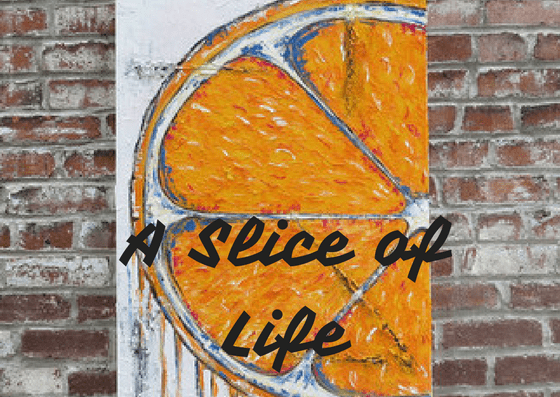
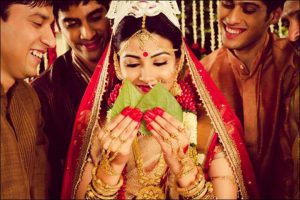


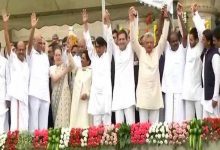

 By
By
 By
By

 By
By